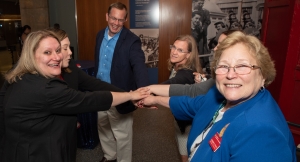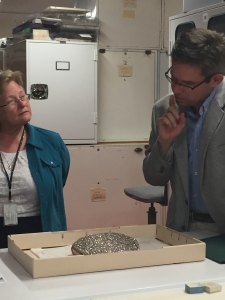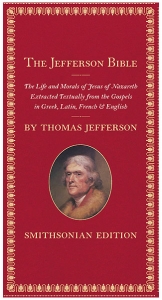Happy Retirement, Rosemary Phillips: You’ve been a great friend to Affiliates!

Rosemary goofing around with the Affiliations staff at NMAH.
Since 2000, Rosemary Phillips has been a program manager at the National Museum of American History (NMAH), handling a myriad of requests from Smithsonian Affiliates, from moving a Civil War-era locomotive, to the loan of over 50 firearms, to championing a performance of early American music and much more. Throughout her decades-long association with Affiliates, Rosemary has displayed the friendliness, commitment, diplomacy, and genuine care for Affiliates that has made the relationship between the Affiliations Program and the National Museum of American History one of the most successful collaborations at the Smithsonian. After 42 years, Rosemary retired on January 3, 2020.
Rosemary started her career at the Smithsonian as a graduate intern at the National Collection of Fine Arts (which has since become the Smithsonian American Art Museum). She started at the National Museum of History and Technology (now the National Museum of American History) in collection management services. She made significant contributions to NMAH’s culture over the years, including leading a staff development committee, helping to create the Museum’s peer recognition awards and Museum-wide cross training program, and creating an annual Girl Scout Day which brought an average of 500 girls and troop leaders to the Museum each year.
After joining the Affiliations Program at NMAH, Rosemary has been essential in realizing some of the biggest accomplishments in the Affiliate network. Here are a few notable ones:

Rosemary with colleagues at the opening of the National Museum of Industrial History.
– When the Durham Museum (Omaha, NE) became an Affiliate in 2002, Rosemary was instrumental in securing a significant number of artifact loans, a collaboration that took over two years. She did the same when the National Museum of American Jewish History (Philadelphia, PA) opened in their new building in 2010.
– Rosemary spearheaded the collaboration with the National Museum of Industrial History, the Smithsonian’s first Affiliate, that opened to the public in 2016 with over 100 artifact loans from NMAH.

Rosemary with former Affiliations Director Harold Closter and his wife at the grand opening of the National Museum of American Jewish History
– She championed the collaboration between Plimoth Plantation (Plymouth, MA) and NMAH’s Religion initiative, which led to a weekend of events featuring a performance of Native and English music traditions, Waking the Ancestors: Recovering the Lost Sacred Sounds of Colonial America.
There are countless more examples which demonstrate Rosemary’s persistence, good cheer, and dedication to being of service to Affiliates, in ways that brought the Smithsonian to their communities – and Affiliate expertise to the Smithsonian – in meaningful and impactful ways. If you have an anecdote to share about your relationship with Rosemary, please post it below in comments!

Rosemary helps a curator from a New York Affiliate evaluate Mamie Eisenhower’s purse for loan.

Rosemary with the staff of the Heinz History Center and NMAH in Pittsburgh.

Rosemary (in blue) watches over first-person Pilgrim interpreters leading visitors in traditional songs at NMAH.

Rosemary with a delicious thank you from an Affiliate in Hershey, PA.




 the field of Revolutionary America. She has spent her career at the National Museum of American History (NMAH) as a curator of early American social and political history. She has curated and co-curated major exhibitions, including The Jefferson Bible;
the field of Revolutionary America. She has spent her career at the National Museum of American History (NMAH) as a curator of early American social and political history. She has curated and co-curated major exhibitions, including The Jefferson Bible; 
 Smithsonian Secretary Dr. Lonnie Bunch will be discussing his new book A Fool’s Errand at the
Smithsonian Secretary Dr. Lonnie Bunch will be discussing his new book A Fool’s Errand at the 


